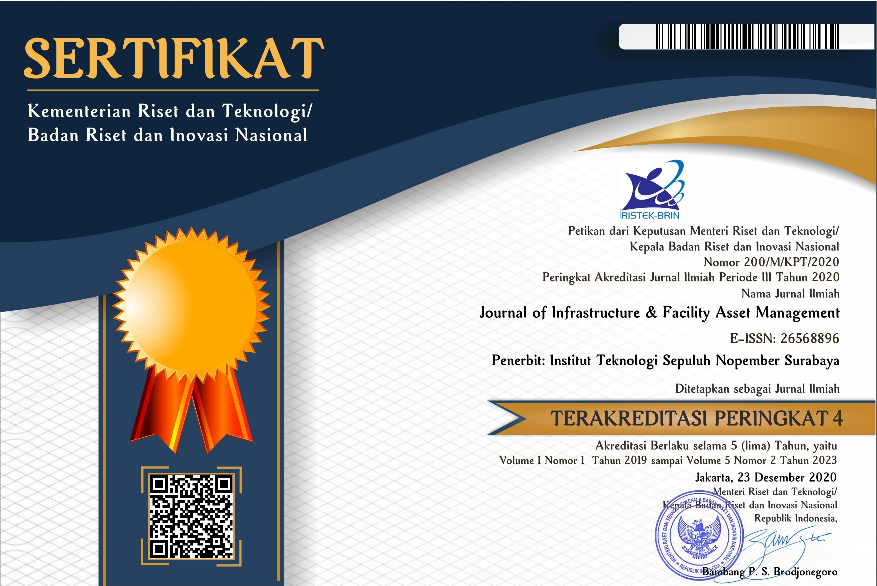Comparison of Embankment Reinforcement Requirements with Geotextile on Soft Soil with 2D and 3D Slope Stability Analysis Methods
Abstract
Slope stability analysis is very important in slope design so it can manage and maintain the infrastructure assets. If the slope is unstable, it can damage the infrastructure around the slope. The method commonly used in slope stability analysis is 2D modeling which assumes the length of the landslide area is not limited or continuous. In fact, landslides that occur in the field are limited and not continuous, so 3D modeling is more suitable than 2D modeling. 3D slope stability analysis has been developed by various researchers. Most of the results of previous studies stated that the 3D and 2D factor of safety ratio was more than one for cohesive soils and less than one for non-cohesive soils. This safety factor affects the amount of reinforcement needed. Differences in 2D and 3D safety factors will cause differences in the amount of reinforcement needed. Therefore, this study was conducted to determine the differences in the 2D and 3D slope stability analysis result. Slope stability analysis was carried out using LEM, where the 2D slope stability used the Fellenius method while the 3D slope stability used the Hovland method. Calculate the required reinforcement amount using geotextiles with Tult = 250 kN/m. The results obtained from this study are the 2D safety factor is smaller than the 3D safety factor. The 3D and 2D safety factor ratios range from 1.09 – 1.397. While the amount of reinforcement required in the 3D analysis is less than in the 2D analysis with the ratio of 3D and 2D reinforcement requirements ranging from 0.5 to 0.955 depending on the width and height of the embankment.
Full Text:
PDFReferences
Bahsan, E. & Fakhriyyanti, R. (2018). “Comparison of 2D and 3D Stability Analyses for Natural Slope”. International Journal of Engineering & Technology 7 : 662-667
Chen, R.H. (1981). Three-Dimensional Slope Stability Analysis. IN: Purdue University. West Lafayette. Indiana.
Chen, R.H. & Chameau, J.L. (1982). “Three-dimensional Limit Equilibrium Analysis of Slopes”. Geotechnique 32(1): 31-40.
Dana, H.Z, Kakaie, K.R., Rafiee, R., & Bafghi, A.R.Y. 2018. ”Effects of Geometrical and Geomechanical Properties on Slope Stability of Open-Pit Mines Using 2D and 3D Finite difference methods”. Journal of Mining & Environment 9 (4) : 941-957.
Das, B.M. (1985). Mekanika Tanah (Prinsip-prinsip Rekayasa Geoteknik) Jilid II. Diterjemahkan oleh Mochtar N.E., dan Mochtar I.B. Erlangga. Jakarta
Gens, A., Hutchinson, J.N., Cavounidis, S. 1988. “Three-dimensional analysis of slides in cohesive soils”. Geotechnique 38(1) : 1-23.
Sari, P.T.K, et al. (2020). “The Comparison Between 2-D and 3-D Slope Stability Analysis Based on Reinforcement Requirements”. Advanced Science Engineering Information Technology 10(5) : 2082-2088.
Septiandri, R.A, et al. (2021). Metode Cepat Untuk Menentukan Besar Pemampatan Konsolidasi (Sc) Pada Timbunan Di Atas Tanah Lunak dan Perencanaan Perkuatannya Untuk Kondisi Dengan dan Tanpa Pemasangan Prefabricated Vertical Drain (PVD). Tesis Pasca Sarjana. Institut Teknologi Sepuluh Nopember (ITS) Surabaya
Septiandri, R.A., et al. (2021). “Analisis Kebutuhan Perkuatan Geotextile untuk Tinggi Timbunan Badan Jalan yang Bervariasi di atas Tanah Lunak pada Kondisi dengan dan tanpa Pemasangan PVD (Prefabricated Vertical Drain)”. Jurnal Aplikasi Teknik Sipil 19 (3) : 283-294.
Shoffiana, N.A., et al. (2021). Perbandingan Hasil Analisa Stabilitas Lereng 2-D dan 3-D terhadap Jumlah Kebutuhan Perkuatannya. Tugas Akhir. Institut Teknologi Sepuluh Nopember (ITS) Surabaya.
SNI 8460:2017. Persyaratan Perancangan Geoteknik. Badan Standarisasi Nasional. Jakarta.
Sugiarto et al (2022). “Analisis Penyebab dan Mekanisme Keruntuhan Lereng Sungai Konaweha, Studi Kasus Ruas Bts. Kab. Konawe Utara/Kab. Konawe – Pohara Km 29+750”. Jurnal Manajemen Aset Infrastruktur & Fasilitas - JMAIF 6(Khusus1) Januari 2022.
Suprayitno, H. & Soemitro, R.A.A. (2018). “Preliminary Reflexion on Basic Principle of Infrastructure Asset Management”. Jurnal Manajemen Aset Infrastruktur & Fasilitas – JMAIF 2(1) Maret 2018.
Suprayitno, H. et al (2020). “Preliminary Reflection on Performance Indicator and Performance Factor for Infrastructure Asset Management”. Journal of Infrastructure & Facility Asset Management - JIFAM 2(1), March 2020.
Wardani, M.K. et al (2019). “Evaluasi Potensi Kelongsoran Pada Lereng Alam Akibat Perubahan Sudut Kemiringan Menggunakan Metode Fellenius”. Jurnal Manajemen Aset Infrastruktur & Fasilitas. Vol. 3, Edisi Khusus 2, Juni 2019.
DOI: http://dx.doi.org/10.12962%2Fjifam.v4i2.14369
Refbacks
- There are currently no refbacks.
Visitor :
Flag Counter

Journal Of Infrastructure & Facility Asset Management by Institut Teknologi Sepuluh Nopember is licensed under a Creative Commons Attribution-ShareAlike 4.0 International License.





